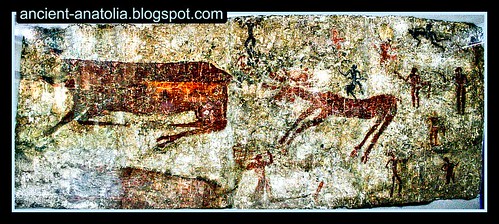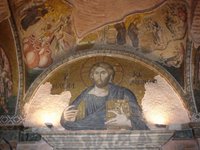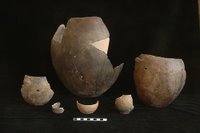 Early Neolithic site in southeastern Turkey dated to 11000 years ago: Göbekli Tepe, Urfa
Early Neolithic site in southeastern Turkey dated to 11000 years ago: Göbekli Tepe, Urfa New settlement discovered in Konya, Turkey, dating back 11,000 years

Etruscans: Anatolian Italians? A recent DNA-based survey suggests the roots of Etruscans, a pre-Roman civilization in Italy, lie in Anatolia.
 An Expedition into the Origins of Civilization: Çatalhöyük first discovered in 1958, brought to worldwide attention by James Mellaart's excavations between 1961 and 1965, which revealed this section of Anatolia as a centre of advanced culture in the Neolithic period. The complex settlement was described by Mellaart as the earliest city in the world. It was a very large Neolithic and Chalcolithic settlement in southern Anatolia, dating from around 7500 BCE for the lowest layers. It is perhaps the largest and most sophisticated Neolithic site yet uncovered. To give a timescale, remember that Stonehenge, a Neolithic and Bronze Age megalithic monument located near Amesbury in the English county of Wiltshire, about 8 miles north of Salisbury, was erected between 2500 BC and 2000 BC although the surrounding circular earth bank and ditch, which constitute the earliest phase of the monument, have been dated to about 3100 BC.
An Expedition into the Origins of Civilization: Çatalhöyük first discovered in 1958, brought to worldwide attention by James Mellaart's excavations between 1961 and 1965, which revealed this section of Anatolia as a centre of advanced culture in the Neolithic period. The complex settlement was described by Mellaart as the earliest city in the world. It was a very large Neolithic and Chalcolithic settlement in southern Anatolia, dating from around 7500 BCE for the lowest layers. It is perhaps the largest and most sophisticated Neolithic site yet uncovered. To give a timescale, remember that Stonehenge, a Neolithic and Bronze Age megalithic monument located near Amesbury in the English county of Wiltshire, about 8 miles north of Salisbury, was erected between 2500 BC and 2000 BC although the surrounding circular earth bank and ditch, which constitute the earliest phase of the monument, have been dated to about 3100 BC.  Lycia (Lycian: Trmmisa) is a region in the modern day Antalya Province on the southern coast of Turkey. The region of Lycia has been inhabited by human groups since prehistoric times. The Lycian Way, waymarked long-distance footpath, follows part of the coast of the region. Ancient Egyptian records describe the Lycians as allies of the Hittites. According to Herodotus, Lycia was named after Lycus, the son of Pandion II, king of Athens. Lycia was frequently mentioned by Homer as an ally of Troy. In Homer's Iliad, the Lycian contingent was said to have been lead by two esteemed warriors: Sarpedon (son of Zeus and Laodamia) and Glaucus (son of Hippolochus).
Lycia (Lycian: Trmmisa) is a region in the modern day Antalya Province on the southern coast of Turkey. The region of Lycia has been inhabited by human groups since prehistoric times. The Lycian Way, waymarked long-distance footpath, follows part of the coast of the region. Ancient Egyptian records describe the Lycians as allies of the Hittites. According to Herodotus, Lycia was named after Lycus, the son of Pandion II, king of Athens. Lycia was frequently mentioned by Homer as an ally of Troy. In Homer's Iliad, the Lycian contingent was said to have been lead by two esteemed warriors: Sarpedon (son of Zeus and Laodamia) and Glaucus (son of Hippolochus).  Cappadocia: In the time of Herodotus the Cappadocians occupied the whole region from Mount Taurus to the Euxine (Black Sea). Cappadocia was known as Hatti in the late Bronze Age, and was the homeland of the Hittite power centred at Hattusa. Cappadocia contains several underground cities, largely used by early Christians as hiding places. The Cappadocian Fathers of the fourth century were integral to much of early Christian philosophy.
Cappadocia: In the time of Herodotus the Cappadocians occupied the whole region from Mount Taurus to the Euxine (Black Sea). Cappadocia was known as Hatti in the late Bronze Age, and was the homeland of the Hittite power centred at Hattusa. Cappadocia contains several underground cities, largely used by early Christians as hiding places. The Cappadocian Fathers of the fourth century were integral to much of early Christian philosophy. The Chora Church (Turkish Kariye Müzesi, Kariye Camii, or Kariye Kilisesi — the Chora Museum, Mosque or Church) is considered to be one of the most beautiful examples of a Byzantine church. The church is situated in the western, Edirnekapı district of Istanbul. In the 16th century, the church was converted into a mosque by the Ottoman rulers, and it became a secularised museum in 1948. The interior of the building is covered with fine mosaics and frescoes.
The Chora Church (Turkish Kariye Müzesi, Kariye Camii, or Kariye Kilisesi — the Chora Museum, Mosque or Church) is considered to be one of the most beautiful examples of a Byzantine church. The church is situated in the western, Edirnekapı district of Istanbul. In the 16th century, the church was converted into a mosque by the Ottoman rulers, and it became a secularised museum in 1948. The interior of the building is covered with fine mosaics and frescoes.Paul of Tarsus, also known as Saul, Paulus, and Saint Paul the Apostle (AD 3–14 — 62–69), is widely considered to be central to the early development and spread of Christianity, particularly westward from Jerusalem. Many Christians view him as an important interpreter of the teachings of Jesus.
 Hattusa (also known as Hattusas, Hattusha or Khattushash) was the capital of the Hittite Empire. Before 2000 BC a settlement of the apparently indigenous Hatti people was established on sites that had been occupied even earlier. The earliest traces of settlement on the site is from the Sixth Millennium BC.
Hattusa (also known as Hattusas, Hattusha or Khattushash) was the capital of the Hittite Empire. Before 2000 BC a settlement of the apparently indigenous Hatti people was established on sites that had been occupied even earlier. The earliest traces of settlement on the site is from the Sixth Millennium BC. The Hattians were an ancient
 people who inhabited the land of Hatti in Asia Minor in the 3rd to 2nd millennia BC. Very few traces from the Paleolithic and Mesolithic periods - when man was still a wandering hunter and gatherer - have been discovered in northern Anatolia. Even from the Neolithic period, when man had begun to settle down to a livelihood of raising his own crops and animals, there is not much more evidence of his populating this region.
people who inhabited the land of Hatti in Asia Minor in the 3rd to 2nd millennia BC. Very few traces from the Paleolithic and Mesolithic periods - when man was still a wandering hunter and gatherer - have been discovered in northern Anatolia. Even from the Neolithic period, when man had begun to settle down to a livelihood of raising his own crops and animals, there is not much more evidence of his populating this region.  Hittites in the Bible: The Hittites (also Hethites) and Children of Heth, translating Hebrew חתי and בני-חת are the second of the eleven Canaanite nations in the Hebrew Bible. They are purportedly descended from one Heth (חֵת), a son of Canaan, son of Ham, and they are mentioned in Genesis as having sold land to Abraham. Identification hypotheses and lst of Biblical references.
Hittites in the Bible: The Hittites (also Hethites) and Children of Heth, translating Hebrew חתי and בני-חת are the second of the eleven Canaanite nations in the Hebrew Bible. They are purportedly descended from one Heth (חֵת), a son of Canaan, son of Ham, and they are mentioned in Genesis as having sold land to Abraham. Identification hypotheses and lst of Biblical references. History of the Hittites: Around 2000 BC, the region centered in Hattusa, that would later become the core of the Hittite kingdom, was inhabited by people with a distinct culture who spoke a non-Indo-European language, "Hattic". In the 14th century BC, the Hittite Empire was at its height, encompassing central Anatolia, north-western Syria as far as Ugarit, and upper Mesopotamia. The history of the Hittite civilization is known mostly from cuneiform texts found in the area of their empire, and from tablets of diplomatic and commercial correspondence found in various archives in Egypt and the Middle East.
History of the Hittites: Around 2000 BC, the region centered in Hattusa, that would later become the core of the Hittite kingdom, was inhabited by people with a distinct culture who spoke a non-Indo-European language, "Hattic". In the 14th century BC, the Hittite Empire was at its height, encompassing central Anatolia, north-western Syria as far as Ugarit, and upper Mesopotamia. The history of the Hittite civilization is known mostly from cuneiform texts found in the area of their empire, and from tablets of diplomatic and commercial correspondence found in various archives in Egypt and the Middle East. Hittites: During sporadic excavations at Boğazköy (Hattusa) that began in 1905, the archaeologist Hugo Winckler found a royal archive with 10,000 tablets, inscribed in cuneiform Akkadian and the same unknown language as the Egyptian letters from Kheta. Biblical Hittites, Children of Heth are said to be a great power who dwell "in the mountains" and "towards the north" of Canaan.
Hittites: During sporadic excavations at Boğazköy (Hattusa) that began in 1905, the archaeologist Hugo Winckler found a royal archive with 10,000 tablets, inscribed in cuneiform Akkadian and the same unknown language as the Egyptian letters from Kheta. Biblical Hittites, Children of Heth are said to be a great power who dwell "in the mountains" and "towards the north" of Canaan. The Trojan War was a war waged, according to legend, against the city of Troy in Asia Minor (present-day Turkey), by the armies of the Achaeans, after Paris of Troy stole Helen from her husband Menelaus, king of Sparta. The war is among the most important events in Greek mythology and was narrated in many works of Greek literature, of which the two most famous are the Iliad and the Odyssey of Homer.
 Troy (Τροία, Ίλιον) is a legendary city and center of the Trojan War, as described in the Trojan War cycle, especially in the Iliad, one of the two epic poems attributed to Homer.Today it is the name of an archaeological site, the traditional location of Homeric Troy, Turkish Truva, in Hisarlık in Anatolia, close to the seacoast in what is now Çanakkale province in northwest Turkey, southwest of the Dardanelles under Mount Ida. A new city of Ilium was founded on the site in the reign of the Roman Emperor Augustus. It flourished until the establishment of Constantinople, and declined gradually during Byzantine times.
Troy (Τροία, Ίλιον) is a legendary city and center of the Trojan War, as described in the Trojan War cycle, especially in the Iliad, one of the two epic poems attributed to Homer.Today it is the name of an archaeological site, the traditional location of Homeric Troy, Turkish Truva, in Hisarlık in Anatolia, close to the seacoast in what is now Çanakkale province in northwest Turkey, southwest of the Dardanelles under Mount Ida. A new city of Ilium was founded on the site in the reign of the Roman Emperor Augustus. It flourished until the establishment of Constantinople, and declined gradually during Byzantine times. Ancient Hittite dam inaugurated after 32 centuries: A Hittite-era dam located in the central Anatolian province of Çorum and believed to be one of the oldest in the world to have survived to date has been restored and is once again serving as a source of irrigation for local residents. The dam, located at the Alacahöyük archaeological site, was built by the Hittites in 1240 B.C. The dam was ordered by Hittite King Tudhaliya IV in the name of goddess Hepat, according to ancient Hittite tablets. After a drought Anatolia suffered in 1200 B.C., Tudhaliya IV imported wheat from Egypt so that his subjects would not suffer a famine. Following this, the king ordered numerous dams to be built in central Anatolia, in 1240 B.C. The construction technique used in building the dam was similar to those of today but that the stone blocks forming the dam were joined with clay instead of cement. The Hittites used the dam to provide both irrigation and tap water. Tap water was collected in a separate pool, and after filtering, the water was carried to the city center two kilometers away. Canals built based on the water's flow astonished us.
Ancient Hittite dam inaugurated after 32 centuries: A Hittite-era dam located in the central Anatolian province of Çorum and believed to be one of the oldest in the world to have survived to date has been restored and is once again serving as a source of irrigation for local residents. The dam, located at the Alacahöyük archaeological site, was built by the Hittites in 1240 B.C. The dam was ordered by Hittite King Tudhaliya IV in the name of goddess Hepat, according to ancient Hittite tablets. After a drought Anatolia suffered in 1200 B.C., Tudhaliya IV imported wheat from Egypt so that his subjects would not suffer a famine. Following this, the king ordered numerous dams to be built in central Anatolia, in 1240 B.C. The construction technique used in building the dam was similar to those of today but that the stone blocks forming the dam were joined with clay instead of cement. The Hittites used the dam to provide both irrigation and tap water. Tap water was collected in a separate pool, and after filtering, the water was carried to the city center two kilometers away. Canals built based on the water's flow astonished us.